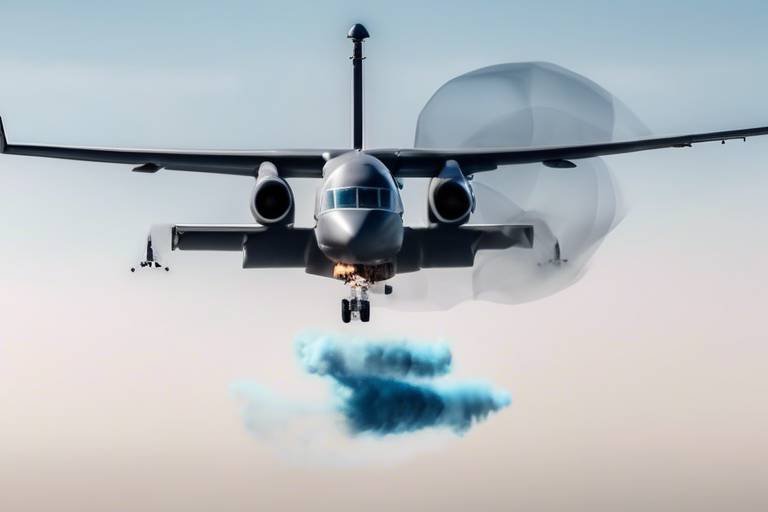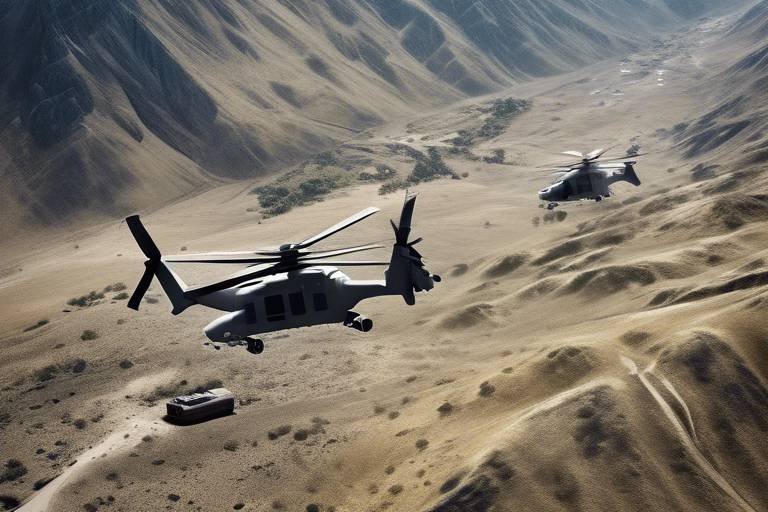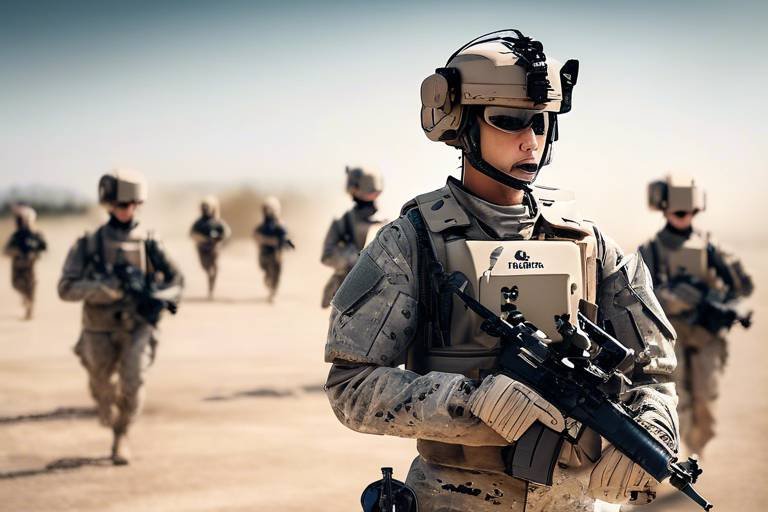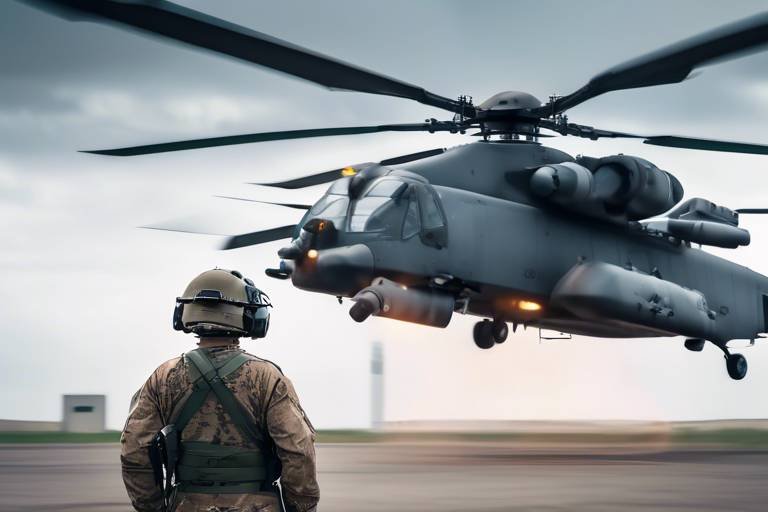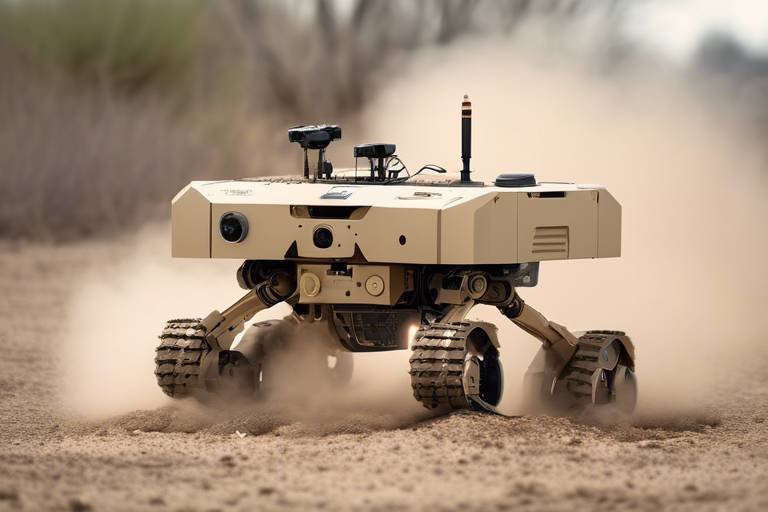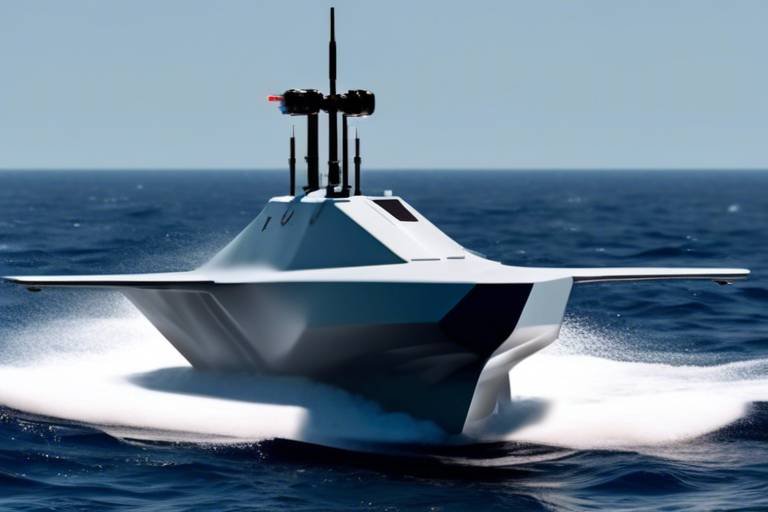How Autonomous Systems are Redefining Military Transport
In the rapidly evolving landscape of modern warfare, autonomous systems are not just a trend; they are a fundamental shift in how military transport operates. Imagine a world where convoys of trucks can navigate treacherous terrains without a single human driver, or where drones can deliver supplies to troops in remote locations with pinpoint accuracy. This is not a scene from a sci-fi movie, but rather the reality that is unfolding before our eyes. The integration of autonomous technologies into military logistics is paving the way for unprecedented efficiency, safety, and operational effectiveness.
The transformative impact of these systems is profound. By leveraging advancements in artificial intelligence, robotics, and sensor technology, military organizations are redefining traditional transport methods. No longer are they limited to human-operated vehicles; instead, they are embracing a future where machines can take on the most dangerous and demanding tasks. This evolution is not just about replacing human effort; it’s about enhancing capabilities, reducing risks, and maximizing the effectiveness of military operations.
As we delve deeper into this topic, we will explore the significant advancements that have made autonomous systems feasible in military transport. We will also highlight the myriad benefits these technologies bring, such as improved safety measures and cost efficiencies. However, it’s not all smooth sailing; challenges such as cybersecurity threats and regulatory hurdles must be addressed to fully realize the potential of autonomous military transport.
In the following sections, we will unpack the evolution of military transport, the technological advancements that have paved the way for autonomy, and the implications of these changes on the battlefield. Get ready to discover how autonomous systems are not just reshaping military logistics, but revolutionizing the very nature of defense operations across the globe.
Understanding how military transport has evolved over the years provides context for the integration of autonomous systems. Historically, military logistics has always been about adapting to the needs of the battlefield. From horse-drawn carriages to armored vehicles, each advancement has sought to improve speed, efficiency, and safety. With the advent of the digital age, the focus has shifted towards integrating technology that enhances operational capabilities. The necessity for efficiency and adaptability in defense logistics has never been more critical, especially in an era where rapid response times can mean the difference between victory and defeat.
Recent technological breakthroughs in artificial intelligence, robotics, and sensor technology have paved the way for autonomous systems. These innovations are crucial in enhancing the capabilities of military transport and logistics. As we explore these advancements, it's clear that the military is not just adopting technology; it's embracing a new paradigm of operation.
AI is revolutionizing logistics by optimizing routes, predicting maintenance needs, and improving decision-making processes. For instance, think about the way GPS navigation has changed our daily commutes. Now, imagine that same technology applied to military logistics, where AI analyzes real-time data to determine the fastest, safest routes for transport vehicles. This capability drastically reduces travel time and resource consumption, ensuring that supplies reach their destinations without unnecessary delays.
Predictive maintenance uses AI to foresee equipment failures, ensuring operational readiness. By minimizing downtime, military transport can maintain a high level of efficiency and reliability. This proactive approach not only saves time but also extends the lifespan of critical equipment, ultimately leading to cost savings and enhanced operational effectiveness.
AI-driven route optimization algorithms analyze various factors to determine the most efficient paths for military transport. This capability reduces travel time and resource consumption significantly. For example, if a convoy can avoid a known traffic jam or hazardous terrain, it not only saves fuel but also enhances the safety of personnel involved.
The integration of robotics and autonomous vehicles is reshaping military transport operations. These machines can operate in environments that are too dangerous for humans, such as active combat zones or areas with environmental hazards. However, the potential of these technologies comes with its own set of challenges, including the need for robust training and maintenance protocols to ensure reliability in the field.
Autonomous systems present numerous benefits, including increased safety, cost savings, and enhanced operational efficiency. The advantages of these technologies contribute to more effective military transport solutions, allowing forces to operate with greater agility and precision.
One of the most significant benefits of autonomous systems is the enhanced safety they provide. By minimizing human involvement in dangerous transport scenarios, the risk to personnel is significantly reduced. Whether it's transporting supplies through hostile territories or evacuating injured soldiers, autonomous systems can operate in high-risk environments without endangering lives.
By automating transport operations, military organizations can significantly cut costs related to labor, fuel, and maintenance. The financial implications of adopting autonomous systems in military logistics are profound. With reduced labor costs and optimized fuel consumption, budgets can be reallocated to other critical areas, enhancing overall mission effectiveness.
Despite their benefits, autonomous systems face challenges such as technological limitations, cybersecurity threats, and regulatory hurdles. Addressing these obstacles is crucial for the successful integration of autonomous military transport.
As military transport becomes increasingly reliant on autonomous systems, cybersecurity risks grow. The importance of securing these systems against potential threats and vulnerabilities cannot be overstated. Just like a fortress needs strong walls, military transport systems need robust cybersecurity measures to protect against hackers and other malicious entities.
The deployment of autonomous military transport raises regulatory and ethical questions. The need for guidelines and policies to ensure responsible use of these technologies is paramount. As we navigate this new terrain, it’s essential to strike a balance between innovation and ethical considerations, ensuring that these powerful tools are used in a manner that aligns with international laws and human rights.
- What are autonomous military transport systems? Autonomous military transport systems are vehicles and technologies that operate without human intervention, utilizing AI and robotics to perform logistics tasks.
- What are the benefits of using autonomous systems in military transport? Benefits include increased safety, cost efficiency, and enhanced operational effectiveness.
- What challenges do autonomous systems face? Challenges include cybersecurity risks, technological limitations, and regulatory hurdles.
- How does AI improve military logistics? AI optimizes routes, predicts maintenance needs, and enhances decision-making processes, leading to more efficient logistics operations.

The Evolution of Military Transport
Understanding the evolution of military transport is like tracing the footsteps of history itself. From the days of horse-drawn carriages to the sophisticated autonomous vehicles we see today, military transport has undergone a dramatic transformation. This evolution is not merely about the vehicles used; it reflects a broader narrative of adaptability and innovation in response to the ever-changing demands of warfare.
In the early stages, military logistics relied heavily on manpower and simple means of transport. Soldiers marched long distances, carrying supplies on their backs, while horses and mules were used to ferry heavier loads. This method, while effective in its time, was fraught with challenges, including fatigue, logistical delays, and the vulnerability of supply lines. As military strategies evolved, so did the need for more efficient and reliable transport solutions.
The introduction of mechanized vehicles during the 20th century marked a significant turning point. Trucks and armored vehicles began to dominate the battlefield, allowing for rapid movement of troops and supplies. This shift not only increased the speed of logistics but also enhanced the strategic flexibility of military operations. However, with these advancements came new challenges, such as the need for maintenance, fuel supply, and the protection of convoys from enemy attacks.
Fast forward to the present day, and we find ourselves at the brink of a new era. The integration of autonomous systems into military transport is revolutionizing how armed forces operate. These systems promise to address many of the historical challenges faced in logistics. For instance, autonomous vehicles can navigate dangerous terrains without putting human lives at risk, while advanced AI algorithms can optimize supply routes in real-time.
To illustrate this evolution, consider the following table that outlines key milestones in military transport:
| Era | Transport Method | Key Features |
|---|---|---|
| Ancient | Horse-drawn Carriages | Manual labor, limited speed |
| World War I | Trucks and Armored Vehicles | Increased speed, mechanization |
| Modern Era | Autonomous Vehicles | AI-driven logistics, enhanced safety |
The future of military transport is poised to be even more exciting. With ongoing advancements in technology, we can expect to see a greater reliance on autonomous systems that not only enhance efficiency but also redefine the very nature of military logistics. As we continue to innovate, the question remains: how will these advancements shape the future of warfare and defense operations around the globe?
- What are autonomous military transport systems? Autonomous military transport systems are vehicles equipped with advanced technologies, allowing them to operate without direct human control.
- How do these systems enhance military logistics? They improve efficiency by optimizing routes, reducing the risk to personnel, and ensuring timely deliveries of supplies.
- What challenges do autonomous systems face? Challenges include cybersecurity threats, regulatory hurdles, and the need for robust ethical guidelines.

Technological Advancements in Autonomy
The landscape of military transport is undergoing a remarkable transformation, largely fueled by . As we delve into this exciting realm, we find ourselves at the intersection of artificial intelligence, robotics, and advanced sensor technology. These innovations are not just enhancing the capabilities of military logistics; they are fundamentally reshaping how operations are conducted on the battlefield.
At the core of this transformation lies artificial intelligence (AI). AI is revolutionizing logistics by enabling systems to process vast amounts of data in real-time. Imagine a scenario where military transport vehicles can analyze traffic patterns, weather conditions, and terrain challenges simultaneously. This capability allows for dynamic decision-making, ensuring that military assets are always in the right place at the right time. By leveraging AI, military planners can predict logistical needs and allocate resources more efficiently, thus enhancing overall operational readiness.
In addition to AI, the integration of robotics is a game-changer. Autonomous vehicles are being designed to handle a variety of tasks, from transporting troops and supplies to conducting reconnaissance missions. These vehicles can operate in environments that are hazardous to human operators, effectively reducing the risk to personnel. For example, consider a convoy of autonomous trucks navigating through a conflict zone. These vehicles can communicate with each other, sharing data about potential threats and adapting their routes in real-time. This level of coordination is akin to a well-rehearsed dance, where every move is calculated and executed flawlessly.
Moreover, the advancements in sensor technology play a crucial role in enhancing the functionality of autonomous systems. Modern sensors can detect obstacles, assess conditions, and even identify potential threats. This capability is vital for autonomous vehicles operating in unpredictable environments. For instance, a drone equipped with advanced sensors can autonomously survey a battlefield, gathering intelligence while avoiding obstacles and threats. The data collected can then be analyzed using AI algorithms to inform strategic decisions on troop movements and logistics.
As we explore the implications of these advancements, it's essential to acknowledge the potential challenges that come with them. While the benefits are substantial, the integration of autonomous systems into military transport is not without hurdles. Issues such as cybersecurity and regulatory compliance must be addressed to ensure these technologies can be deployed safely and effectively. The military must develop robust frameworks to protect these systems from potential cyber threats, which are becoming increasingly sophisticated.
In summary, the technological advancements in autonomy are setting the stage for a new era in military transport. With AI, robotics, and sensor technology at the forefront, we are witnessing a paradigm shift that promises to enhance operational efficiency, safety, and adaptability. As these technologies continue to evolve, their integration into military logistics will undoubtedly redefine how nations approach defense operations.
- What are autonomous systems in military transport? Autonomous systems refer to vehicles and technologies that can operate independently without human intervention, utilizing AI and robotics.
- How does AI improve military logistics? AI enhances logistics by optimizing routes, predicting maintenance needs, and improving decision-making processes, leading to increased efficiency.
- What are the safety benefits of autonomous military transport? Autonomous systems reduce the risk to personnel by minimizing human involvement in dangerous transport scenarios, ensuring safer operations.
- What challenges do autonomous systems face in military applications? Challenges include cybersecurity risks, technological limitations, and the need for regulatory frameworks to guide their deployment.

Artificial Intelligence in Logistics
Artificial Intelligence (AI) is currently revolutionizing the landscape of military logistics, acting as a catalyst for change and innovation. Imagine a world where military transport systems can predict issues before they arise, optimize routes in real-time, and make informed decisions without human intervention. This is not just a futuristic dream; it's a reality being shaped by AI technologies today. By harnessing the power of AI, military organizations can enhance their operational efficiency, reduce costs, and improve overall mission success rates.
One of the most significant ways AI enhances logistics is through predictive analytics. This advanced capability allows military planners to analyze vast amounts of data from various sources, identifying patterns and trends that human operators might overlook. For instance, AI can predict when a vehicle is likely to require maintenance, based on its usage patterns and historical data. This foresight enables military units to schedule maintenance proactively, ensuring that their transport assets are always ready for deployment.
Moreover, AI-driven route optimization algorithms can analyze real-time data, such as weather conditions, traffic patterns, and potential threats, to determine the most efficient paths for military transport. This not only minimizes travel time but also conserves valuable resources, such as fuel and manpower. By streamlining logistics in this way, military operations can become more agile, adapting quickly to changing circumstances on the ground.
To illustrate the impact of AI on military logistics, consider the following table that summarizes key benefits:
| Benefit | Description |
|---|---|
| Predictive Maintenance | AI forecasts equipment failures, reducing downtime and enhancing readiness. |
| Route Optimization | Real-time analysis of conditions to ensure the most efficient travel paths. |
| Data-Driven Decision Making | Enhanced decision-making capabilities through data analysis and trend identification. |
Additionally, AI's role in logistics extends beyond mere operational efficiency. It also plays a crucial role in risk management. By analyzing data on potential threats, AI systems can help military planners devise strategies to mitigate risks during transport operations. This proactive approach not only protects personnel and assets but also ensures that missions can proceed smoothly, even in hostile environments.
In conclusion, the integration of AI into military logistics is not just a trend; it is a fundamental shift that enhances the efficiency and effectiveness of transport operations. As we continue to explore the capabilities of AI, the military stands to gain a significant advantage in both strategic planning and operational execution. With AI as a partner, the future of military logistics looks not only promising but also incredibly exciting.
- What is AI's role in military logistics? AI enhances efficiency by predicting maintenance needs, optimizing routes, and facilitating data-driven decision-making.
- How does predictive maintenance work? Predictive maintenance uses AI algorithms to analyze historical data, predicting when equipment might fail and scheduling maintenance accordingly.
- Can AI improve safety in military transport? Yes, by minimizing human involvement in dangerous situations and providing real-time data analysis, AI can enhance safety measures significantly.
- What are the challenges of implementing AI in military logistics? Challenges include technological limitations, cybersecurity concerns, and the need for regulatory frameworks to guide responsible use.

Predictive Maintenance
In the fast-paced world of military logistics, maintaining operational readiness is not just important; it’s critical. Enter , a game-changing approach that leverages the power of artificial intelligence (AI) to foresee equipment failures before they happen. Imagine being able to predict when a vehicle will need repairs, much like how a seasoned mechanic can sense when an engine might sputter. This proactive strategy minimizes downtime and ensures that military transport can operate at peak efficiency.
Predictive maintenance uses a variety of data inputs, including sensor readings, historical maintenance records, and operational data, to create a comprehensive picture of equipment health. By analyzing this information, AI algorithms can identify patterns and anomalies that signal potential issues. For instance, if a truck's engine temperature consistently spikes after a certain number of hours of operation, the system can alert maintenance crews to check it before it breaks down. This not only saves time but also resources, as it allows for repairs to be scheduled during regular maintenance windows rather than in the heat of a crisis.
Furthermore, the impact of predictive maintenance extends beyond just individual vehicles. When applied across an entire fleet, it can lead to significant cost savings and improved resource allocation. By understanding which vehicles are likely to require maintenance soon, military planners can better allocate resources, ensuring that the most critical missions are supported by fully operational vehicles. The following table illustrates the potential benefits of implementing predictive maintenance in military transport:
| Benefit | Description |
|---|---|
| Reduced Downtime | Anticipating failures allows for timely repairs, keeping vehicles operational. |
| Cost Savings | Less emergency maintenance reduces overall repair costs and extends vehicle lifespan. |
| Enhanced Readiness | Ensures that military units are always equipped with fully functional equipment. |
| Data-Driven Decisions | Utilizes data analytics to inform maintenance schedules and resource allocation. |
However, while the benefits are clear, implementing predictive maintenance isn’t without its challenges. Organizations must invest in training personnel to interpret data effectively, as well as in the technology to collect and analyze that data. Additionally, there’s a need for a cultural shift within military organizations, moving from a reactive mindset to a proactive one. But as military operations continue to evolve, embracing predictive maintenance could very well be the key to staying ahead of the curve.
- What is predictive maintenance? Predictive maintenance is a proactive maintenance strategy that uses data analysis to predict when equipment will fail, allowing for timely repairs.
- How does predictive maintenance benefit military transport? It reduces downtime, saves costs, enhances operational readiness, and enables data-driven decision-making.
- What technologies are used in predictive maintenance? Technologies include AI algorithms, sensors, and data analytics tools that monitor equipment health.
- What challenges are associated with implementing predictive maintenance? Challenges include the need for training, investment in technology, and a shift in organizational culture.

Route Optimization
In the realm of military transport, has emerged as a game-changer, significantly enhancing operational efficiency and resource management. Imagine a world where military vehicles can navigate complex terrains and unpredictable weather conditions without the need for constant human oversight. This is not just a fantasy; it’s a reality thanks to cutting-edge algorithms powered by artificial intelligence (AI).
At its core, route optimization involves analyzing a multitude of factors to determine the most effective paths for military transport. These factors include terrain types, traffic conditions, fuel consumption, and even the potential for enemy engagement. By leveraging sophisticated AI-driven algorithms, military planners can predict the best routes, minimizing travel time and maximizing safety.
For instance, consider a convoy of supply trucks tasked with delivering essential goods to a forward operating base. Traditional methods might rely on pre-set routes that could become compromised due to enemy activity or natural obstacles. However, with AI-enhanced route optimization, the convoy can dynamically adjust its path in real-time based on live data inputs. This capability not only saves time but also reduces the risk of ambush, ultimately ensuring that supplies reach their destination safely and efficiently.
Moreover, the benefits of route optimization extend beyond just immediate travel efficiency. By analyzing historical data and predicting future conditions, military logistics can achieve a level of foresight that was previously unattainable. For example, if a particular route is known to be congested during certain times of the day, AI systems can suggest alternative paths, thereby avoiding delays and conserving fuel. This proactive approach to logistics is akin to having a seasoned navigator on board, one who knows the terrain intimately and can steer clear of potential hazards.
However, the implementation of route optimization is not without its challenges. The reliance on technology means that military operations must also consider the cybersecurity implications of these advanced systems. Protecting the data that informs route optimization algorithms is crucial, as any breach could lead to disastrous consequences on the battlefield. Additionally, training personnel to understand and trust these systems is vital, as the transition from human-led decision-making to AI-driven processes can be daunting.
In summary, route optimization is revolutionizing military transport by combining advanced AI algorithms with real-time data analysis. The result is a more agile, efficient, and safer logistics operation that can adapt to the ever-changing landscape of military engagements. As we continue to embrace these technologies, the potential for enhanced operational effectiveness becomes not just a possibility, but a reality.
- What is route optimization in military transport?
Route optimization refers to the use of advanced algorithms to determine the most efficient paths for military vehicles, taking into account various factors such as terrain, traffic, and potential threats. - How does AI contribute to route optimization?
AI enhances route optimization by analyzing vast amounts of data in real-time, allowing military planners to adjust routes dynamically based on current conditions and historical patterns. - What are the benefits of using route optimization?
Benefits include reduced travel time, increased safety for personnel, better resource management, and the ability to avoid potential threats or obstacles. - What challenges does route optimization face?
Challenges include cybersecurity risks associated with data breaches and the need for personnel training to effectively use AI-driven systems.

Robotics and Autonomous Vehicles
The integration of robotics and autonomous vehicles is not just a trend; it's a revolution reshaping military transport operations. Imagine a convoy of unmanned vehicles traversing hostile terrain, navigating obstacles with pinpoint accuracy, and delivering supplies without putting human lives at risk. This is no longer a scene from a futuristic movie; it’s becoming a reality thanks to advancements in technology. These autonomous systems are equipped with sophisticated sensors, cameras, and artificial intelligence that allow them to operate independently or in coordination with human operators.
One of the most exciting aspects of autonomous vehicles in military transport is their ability to operate in dangerous environments. Whether it's a battlefield or a disaster zone, these vehicles can execute missions that would be too risky for human drivers. For instance, consider the deployment of autonomous drones for reconnaissance missions. These drones can gather intelligence and assess threats from the air, providing crucial information without exposing soldiers to danger. This capability not only enhances operational efficiency but also significantly reduces the risk of casualties.
Furthermore, the use of robotics in military logistics extends beyond just transport. Robotic systems can assist in loading and unloading cargo, managing inventory, and even conducting repairs. This multifaceted approach allows military operations to maintain a high level of readiness and responsiveness. For example, autonomous ground vehicles can deliver supplies to remote outposts while robotic arms handle the unloading process, ensuring that troops receive the necessary resources without delay.
However, the road to full integration of robotic systems and autonomous vehicles is not without its challenges. One primary concern is the reliability of these technologies in unpredictable environments. Military operations often take place under extreme conditions, and any failure in an autonomous system could lead to catastrophic consequences. Therefore, rigorous testing and validation are essential before these systems can be fully deployed.
Moreover, while these autonomous vehicles can greatly enhance military efficiency, there are also ethical considerations to address. The decision-making capabilities of autonomous systems raise questions about accountability and responsibility in combat scenarios. Who is to blame if an autonomous vehicle makes a mistake? As we embrace these technologies, it’s crucial to establish clear guidelines and policies to navigate these complex issues.
In summary, the integration of robotics and autonomous vehicles in military transport is a game-changer. From enhancing safety and efficiency to redefining operational tactics, these technologies are paving the way for a new era in defense logistics. As we continue to innovate and adapt, the military landscape will undoubtedly evolve, making way for smarter, safer, and more effective transport solutions.
- What are the main benefits of using autonomous vehicles in military transport?
Autonomous vehicles increase safety by reducing human involvement in dangerous missions, enhance operational efficiency, and can significantly cut costs related to labor and maintenance. - How do robotic systems improve military logistics?
Robotic systems assist in tasks such as loading and unloading cargo, managing inventory, and conducting repairs, which helps maintain high levels of readiness and responsiveness. - What challenges do autonomous systems face in military applications?
Challenges include technological reliability, cybersecurity risks, and ethical considerations regarding accountability in decision-making processes.

Benefits of Autonomous Military Transport
The integration of autonomous systems into military transport is not just a technological leap; it represents a paradigm shift in how armed forces operate. One of the most compelling benefits of these systems is the **enhanced safety** they provide. By reducing human involvement in high-risk transport scenarios, military personnel are less exposed to danger. Imagine a convoy navigating through hostile territory without the constant threat to human lives; autonomous vehicles can take the forefront, allowing soldiers to focus on their primary mission rather than worrying about potential ambushes.
Moreover, the **cost efficiency** of autonomous military transport cannot be overstated. Traditional logistics require significant expenditure on labor, fuel, and maintenance. By automating these processes, military organizations can redirect valuable resources to other critical areas. For instance, the savings from reduced fuel consumption and lower maintenance costs can be substantial. A recent study indicated that autonomous systems could potentially cut logistics costs by up to **30%**, enabling the military to allocate funds to advanced weaponry or training programs. This financial flexibility can significantly enhance operational readiness and effectiveness.
Additionally, autonomous systems contribute to **operational efficiency**. With advanced algorithms and artificial intelligence, these vehicles can analyze real-time data to make informed decisions about routes and logistics. This leads to faster delivery times and more reliable supply chains. For example, AI-driven route optimization can reduce travel time by identifying the quickest paths while considering factors like terrain and weather conditions. In a military context, time is often of the essence, and these systems can make the difference between success and failure in critical missions.
Another notable advantage is the **scalability** of autonomous transport systems. As military needs evolve, these systems can be adapted and scaled to meet changing demands. Whether it’s deploying additional vehicles for a large-scale operation or adjusting routes based on real-time intelligence, the flexibility of autonomous systems ensures that military logistics can keep pace with the dynamic nature of modern warfare.
In summary, the benefits of autonomous military transport are multifaceted. They range from increased safety for personnel to significant cost savings and enhanced operational efficiency. As these technologies continue to develop, the potential for even greater improvements in military logistics becomes apparent. However, as we embrace these advancements, it's crucial to remain vigilant about the accompanying challenges and ethical considerations.
- What are the primary benefits of autonomous military transport?
Autonomous military transport offers enhanced safety, cost efficiency, operational efficiency, and scalability, transforming logistics operations.
- How do autonomous systems improve safety in military transport?
By minimizing human involvement in dangerous situations, autonomous systems reduce the risk to personnel, allowing them to focus on their missions.
- What financial savings can be expected from using autonomous systems?
Studies suggest that autonomous systems can reduce logistics costs by up to 30%, allowing military organizations to allocate resources more effectively.
- How does AI contribute to military logistics?
AI enhances logistics by optimizing routes, predicting maintenance needs, and improving decision-making processes, leading to more efficient operations.

Enhanced Safety Measures
In the realm of military transport, safety has always been a paramount concern. The integration of autonomous systems introduces a revolutionary shift towards that significantly reduce risks associated with human error and hazardous environments. Imagine a convoy of military vehicles navigating through a conflict zone; traditionally, this would involve human drivers who, despite their training, are still susceptible to fatigue, distraction, and stress. However, with autonomous systems, the reliance on human operators is dramatically minimized, leading to safer transport operations.
One of the most compelling aspects of autonomous military transport is its ability to operate in dangerous conditions without putting personnel at risk. For instance, autonomous vehicles can be deployed in areas where IEDs (Improvised Explosive Devices) are prevalent, effectively acting as a shield for human soldiers. These vehicles are equipped with advanced sensors and AI algorithms that allow them to detect threats and navigate obstacles in real-time, ensuring safe passage even in the most perilous environments.
Furthermore, the use of autonomous systems can significantly enhance situational awareness. Equipped with sophisticated sensor technology, these vehicles can gather and analyze data from their surroundings, providing commanders with critical information that can be used to make informed decisions. This capability not only improves the safety of the transport operation itself but also contributes to the overall success of military missions.
To illustrate the impact of these safety measures, consider the following table that outlines key advantages of autonomous systems in military transport:
| Safety Feature | Description |
|---|---|
| Reduced Human Error | Minimizes risks associated with fatigue and distraction, leading to safer operations. |
| Real-time Threat Detection | Utilizes advanced sensors to identify and respond to threats in real-time. |
| Remote Operation | Allows for transport operations to be conducted from a safe distance, protecting personnel. |
| Data-Driven Decision Making | Enhances situational awareness through comprehensive data analysis. |
In addition to these technological advancements, the implementation of autonomous systems also fosters a culture of safety within military organizations. As personnel witness the effectiveness and reliability of these systems, they can focus on strategic planning and execution rather than worrying about the inherent dangers of transport missions. This shift not only enhances morale but also promotes a proactive approach to safety across all levels of military operations.
In conclusion, the enhanced safety measures provided by autonomous military transport systems are revolutionizing how defense operations are conducted. By minimizing human involvement in high-risk scenarios and leveraging advanced technologies, these systems are setting new standards for safety in military logistics. As we continue to explore the integration of these technologies, it becomes increasingly clear that the future of military transport is not just about efficiency; it's also about safeguarding the lives of those who serve.
- What are autonomous military transport systems? Autonomous military transport systems are vehicles equipped with advanced technologies that allow them to operate without human intervention, enhancing safety and efficiency in military logistics.
- How do these systems improve safety? They reduce the risk of human error, provide real-time threat detection, and allow for remote operations, keeping personnel out of harm's way.
- What technologies are used in autonomous military transport? Technologies include artificial intelligence, advanced sensors, robotics, and data analytics, all of which work together to enhance operational capabilities.
- Can autonomous systems operate in combat zones? Yes, they are designed to navigate hazardous environments, making them ideal for use in combat zones where human lives are at risk.

Cost Efficiency
Cost efficiency is one of the most compelling reasons for the military to embrace autonomous transport systems. Imagine a scenario where logistics operations are not only streamlined but also significantly less expensive. That's the promise of automation in military transport. By deploying autonomous vehicles and drones, the military can reduce labor costs drastically. Traditional transport methods often require a large number of personnel to operate, manage, and maintain vehicles. With autonomous systems, the reliance on human operators diminishes, leading to substantial savings.
Moreover, fuel consumption can be optimized through advanced algorithms that autonomous systems utilize for route planning. These algorithms take into account various factors such as traffic conditions, terrain, and even weather forecasts. The result? A reduction in fuel costs, which can be a major budgetary concern for military operations. Think of it like having a personal assistant who not only schedules your meetings but also ensures you take the most efficient route to save time and fuel.
To put this into perspective, consider the following table that illustrates potential cost savings based on different aspects of military logistics:
| Cost Factor | Traditional Method Cost | Autonomous Method Cost | Estimated Savings |
|---|---|---|---|
| Labor | $500,000 | $200,000 | $300,000 |
| Fuel | $300,000 | $150,000 | $150,000 |
| Maintenance | $100,000 | $50,000 | $50,000 |
| Total | $900,000 | $400,000 | $500,000 |
As illustrated, the potential savings can amount to a staggering $500,000 per operation cycle. This cost efficiency not only enhances the military's operational budget but also allows for reallocating funds towards other critical areas, such as training and technology development. In essence, the savings generated from autonomous transport can lead to a more agile and capable military force.
However, it's important to note that while the initial investment in autonomous technology may seem high, the long-term savings make it a worthwhile endeavor. The military can invest in cutting-edge technologies that ultimately pay for themselves through efficiency gains. This cycle of reinvestment can create a virtuous circle where savings lead to further innovation and capability enhancements.
- What are the main cost-saving benefits of autonomous military transport? Autonomous military transport reduces labor costs, optimizes fuel consumption, and minimizes maintenance expenses, leading to significant overall savings.
- How does route optimization contribute to cost efficiency? Route optimization uses AI algorithms to determine the most efficient paths, which reduces travel time and fuel consumption, thereby lowering costs.
- Are there any initial costs associated with implementing autonomous systems? Yes, while there is an initial investment in technology, the long-term savings in operational costs typically outweigh these upfront expenses.
- Can autonomous transport systems operate in all military environments? While autonomous systems are designed to operate in various environments, their effectiveness can vary based on terrain, weather, and operational conditions.

Challenges and Limitations
As we dive into the world of autonomous military transport, it’s crucial to acknowledge that this innovative technology doesn't come without its share of . While the potential benefits are immense, the road to full integration is fraught with hurdles that need to be addressed. One of the primary concerns is the technological limitations inherent in current autonomous systems. Despite rapid advancements, these systems still struggle with complex environments and unpredictable scenarios that can arise on the battlefield. Imagine a self-driving vehicle trying to navigate through a war-torn area filled with debris and active threats—it's a daunting challenge!
Another significant hurdle is the looming specter of cybersecurity risks. As military transport increasingly relies on autonomous systems, the potential for cyberattacks grows exponentially. Hackers could potentially take control of these vehicles, leading to catastrophic consequences. The military must invest heavily in cybersecurity measures to safeguard these systems against threats. This means not only implementing robust security protocols but also continually updating them to counteract evolving cyber threats.
Furthermore, the integration of autonomous systems raises regulatory and ethical considerations. The question of accountability looms large—if an autonomous vehicle makes a mistake, who is responsible? Is it the manufacturer, the military, or the software developers? These questions necessitate the development of comprehensive guidelines and policies that govern the use of autonomous technologies in military operations. The military must ensure that these systems are used responsibly and ethically, which adds another layer of complexity to their deployment.
In addition to these challenges, there are also operational limitations to consider. Autonomous systems may not yet be equipped to handle all types of military transport tasks. For example, they might excel in logistics and supply chain management but struggle with tasks that require human intuition and judgment. The military must carefully evaluate which operations can be effectively automated and which still require human oversight.
To summarize, while the promise of autonomous military transport is exciting, it is essential to navigate the challenges that accompany this technology. From addressing technological limitations and cybersecurity risks to establishing regulatory frameworks, the path forward requires a concerted effort from all stakeholders involved. As we move toward a future where autonomous systems play a pivotal role in military operations, we must remain vigilant and proactive in tackling these challenges.
- What are the main challenges of autonomous military transport?
The main challenges include technological limitations, cybersecurity risks, and regulatory and ethical considerations.
- How can cybersecurity risks be mitigated?
By investing in robust cybersecurity measures and continually updating security protocols to counteract evolving threats.
- What ethical considerations are involved in using autonomous systems?
Accountability is a major ethical consideration, as it raises questions about who is responsible for errors made by autonomous systems.

Cybersecurity Risks
As military transport systems increasingly integrate autonomous technologies, the importance of cybersecurity cannot be overstated. Just imagine a world where drones are delivering supplies to troops in remote locations or autonomous vehicles are navigating through hostile territories without human oversight. While this paints a picture of efficiency and innovation, it also opens the door to a myriad of cybersecurity risks that could have catastrophic consequences. The potential for cyberattacks on these systems poses a significant threat to national security and operational integrity.
One of the primary concerns is the vulnerability of autonomous systems to hacking. Cybercriminals and hostile entities could exploit weaknesses in the software or communication networks that control these systems. A successful attack could lead to unauthorized access, manipulation of operations, or even complete control of military transport vehicles. This scenario is not just a theoretical worry; it’s a real concern that military organizations must address proactively.
Moreover, the complexity of these systems adds another layer of risk. Autonomous vehicles often rely on a network of sensors, cameras, and artificial intelligence to function effectively. If any component of this network is compromised, the vehicle's ability to operate safely and efficiently could be severely hindered. For instance, if a sensor is tampered with, it might misinterpret its environment, leading to disastrous outcomes. Therefore, ensuring that every element of the system is secure is paramount.
To tackle these challenges, military organizations must prioritize cybersecurity measures. This includes implementing robust encryption protocols, conducting regular security audits, and investing in advanced threat detection systems. Training personnel to recognize and respond to potential cyber threats is equally important. After all, the human element often serves as the first line of defense against cyber intrusions.
Additionally, collaboration with technology experts and cybersecurity firms can help military organizations stay ahead of emerging threats. By sharing knowledge and resources, they can develop more resilient systems capable of withstanding cyberattacks. It's a continuous battle of innovation against malicious intent, and staying one step ahead is crucial.
In summary, while the integration of autonomous systems in military transport offers numerous advantages, it also introduces significant cybersecurity risks. Addressing these vulnerabilities requires a multifaceted approach that encompasses technology, training, and collaboration. As the landscape of military logistics evolves, so too must the strategies to protect these essential systems from cyber threats.
- What are the main cybersecurity risks associated with autonomous military transport?
Cybersecurity risks include hacking, unauthorized access, manipulation of operations, and vulnerabilities in the software and communication networks that control these systems. - How can military organizations mitigate these cybersecurity risks?
Organizations can mitigate risks by implementing robust encryption, conducting regular security audits, investing in advanced threat detection systems, and training personnel to recognize potential cyber threats. - Why is collaboration important in addressing cybersecurity challenges?
Collaboration with technology experts and cybersecurity firms helps military organizations stay ahead of emerging threats and develop more resilient systems.

Regulatory and Ethical Considerations
The rise of autonomous military transport systems brings with it a myriad of that cannot be overlooked. As these technologies rapidly evolve, they challenge existing legal frameworks and demand new regulations to ensure their responsible use. The integration of autonomous systems into military operations raises questions about accountability, liability, and the ethical implications of deploying machines in conflict scenarios.
One major concern is the accountability for decisions made by autonomous systems. When a military vehicle makes a decision that leads to unintended consequences, such as collateral damage, who is held responsible? Is it the manufacturer, the military personnel who deployed the system, or the AI itself? These questions highlight the need for clear guidelines that define responsibility in the event of a mishap.
Moreover, ethical considerations come into play when discussing the use of autonomous systems in warfare. The potential for machines to make life-and-death decisions raises serious moral dilemmas. For instance, should a robot be allowed to engage targets without human intervention? This concern has sparked debates among ethicists, military leaders, and policymakers alike, emphasizing the need for a robust ethical framework that governs the deployment of such technologies.
To address these challenges, military organizations and governments must collaborate to establish comprehensive regulations that cover various aspects of autonomous military transport. These regulations should include:
- Safety Standards: Ensuring that autonomous systems meet rigorous safety requirements to minimize risks to both military personnel and civilians.
- Data Privacy: Protecting sensitive information collected by autonomous systems from unauthorized access and exploitation.
- Operational Guidelines: Creating clear rules for the use of autonomous systems in combat, including limitations on their deployment in certain scenarios.
Additionally, international cooperation is crucial in developing regulations that transcend national boundaries. As autonomous military transport becomes more prevalent, it is imperative to establish global norms and agreements that govern their use. This can help prevent an arms race in autonomous weapons technology and promote responsible practices among nations.
In conclusion, the integration of autonomous systems into military transport presents both opportunities and challenges. By proactively addressing regulatory and ethical considerations, the military can harness the benefits of these technologies while minimizing risks and ensuring their responsible use in defense operations.
- What are the main ethical concerns regarding autonomous military transport?
The primary ethical concerns include accountability for decisions made by machines, the morality of allowing robots to engage targets without human oversight, and the potential for misuse of these technologies. - How can regulations be established for autonomous military systems?
Regulations can be established through collaboration among military organizations, governments, and international bodies to create comprehensive guidelines that address safety, data privacy, and operational standards. - What role does international cooperation play in regulating autonomous military transport?
International cooperation is essential to develop global norms and agreements that govern the use of autonomous technologies, preventing an arms race and promoting responsible practices.
Frequently Asked Questions
-
What are autonomous systems in military transport?
Autonomous systems in military transport refer to technologies that operate without human intervention. These include self-driving vehicles, drones, and robotic systems designed to enhance logistics and transport operations. By leveraging advanced technologies like artificial intelligence and robotics, these systems can navigate, transport, and deliver supplies efficiently and safely.
-
How do autonomous systems improve military logistics?
Autonomous systems significantly enhance military logistics by optimizing routes, predicting maintenance needs, and reducing human error. For instance, AI-driven algorithms can analyze traffic patterns and environmental conditions to find the quickest and safest routes for transport. This not only saves time but also conserves resources, making military operations more effective.
-
What are the safety benefits of using autonomous military transport?
One of the key safety benefits of autonomous military transport is the reduction of risk to personnel. By minimizing human involvement in high-stakes transport scenarios, such as delivering supplies in combat zones, the likelihood of injury or loss of life decreases significantly. Autonomous systems can operate in dangerous environments where human presence would be too risky.
-
What challenges do autonomous systems face in military transport?
Despite their advantages, autonomous systems encounter several challenges, including technological limitations, cybersecurity threats, and regulatory hurdles. For example, ensuring the security of these systems against hacking and other cyber threats is critical, as vulnerabilities could be exploited to disrupt military operations.
-
How does predictive maintenance work in military transport?
Predictive maintenance utilizes AI to analyze data from equipment to predict when maintenance should be performed. This proactive approach helps prevent unexpected failures, ensuring that transport vehicles and systems are always operational and ready for deployment, thus maintaining a high level of efficiency in military logistics.
-
What are the cost implications of adopting autonomous systems?
Adopting autonomous systems can lead to significant cost savings for military organizations. By automating transport operations, expenses related to labor, fuel, and maintenance can be drastically reduced. This financial efficiency allows military budgets to be allocated more effectively, enhancing overall operational capabilities.
-
What ethical considerations arise from the use of autonomous military transport?
The deployment of autonomous military transport raises important ethical questions, particularly regarding accountability and decision-making in combat situations. As these systems become more integrated into military operations, establishing clear guidelines and policies is essential to ensure their responsible use and to address potential moral dilemmas.


